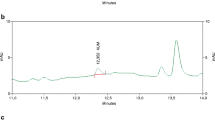Abstract
Varroa destructor, an ectoparasitic mite, is one of the major pests of honeybees in many parts of the world. In order to keep bee colonies alive and productive, effective biological, biotechnical, or acaricidal control measures are necessary. Oxalic acid is one substance under discussion to replace synthetic acaricides (e.g. pyrethroids, organophosphates) to minimize the risk of residues in bee products. The application of oxalic acid based solutions (Bienenwohl or a self-prepared oxalic acid solution with sugar) to control Varroa destructor resulted in no relevant changes in the oxalic acid content of honey produced the following year, compared with honey samples from untreated colonies from the same location. The range of oxalic acid content in honey was 5–68 mg/kg in oxalic acid treated and 5–65 mg/kg in untreated colonies. The oxalic acid content of the honey was positively correlated with its electrical conductivity and thus with its original nectar or honeydew source.




Similar content being viewed by others
References
Radetzki T (1994) Allg Dtsch Imkerzeitung 28(12):11–15
Charrière J D, Imdorf A, Fluri P (1998) Schweiz Bienen-Zeitung 121:503–506
Charrière J D, Imdorf A (2001) Schweiz Bienen-Zeitung 124:18–22
Moosbeckhofer R (2001) Bienenvater 122:7–12
Gumpp T, Drysch K, Radjaipour M, Dartsch P (2003) Bienenvater 124:6–11
Bogdanov S, Charrière JD, Imdorf A, Kilchenmann V, Fluri P (2002) Apidologie 33:399–409
Wallner K (1991) Allg Dtsch Imkerzeitung 25(8):28–29
Unterweger H, Wacha C, Bandion F (2001) Ernährung/Nutrition 25(3):111–115
Institute for Foodstuffs (2001) Methodenbuch zur chemisch-physikalischen Honigprüfung (Draft). Austrian Agency for Health and Food Safety (AGES), Vienna, Austria
Aumeier P (1998) Die Biene 134(8):XVII–XX
Floris I, Satta A, Mutinelli F, Prandin L (1998) Redia 81:143–150
Imdorf A, Charrière JD, Kilchenmann V, Bachofen B, Bogdanov S, Fluri P (1998) Forschungsanstalt für Milchwirtschaft (FAM), Sektion Bienen, Liebefeld, 3003 Bern, Mitteilungen der Sektion Bienen Nr. 27:27
Mutinelli F, Baggio A, Capolongo F, Piro R, Prandin L, Biasion L (1997) Apidologie 28:461–462
Radetzki T, Bärmann M, Sicurella G (2000) Imkerfreund 55(11):9–11
Liebig G (1999) Dtsch Bienen J 7:408–409
Mutinelli F, Baggio A, Capolongo F, Piro R, Biasion L (1997) L`APE nostra amica XIX:4–8
Mutinelli F, Capolongo F, Baggio A, Piro R, Schivo A (1997) J Vet Pharmacol Therap 20 (Suppl. 1):127–180
Bogdanov S, Kilchenmann V, Fluri P, Bühler U, Lavanchy P (1998) Schweiz Bienen-Zeitung 121:581–585
Büchler R (1999) Imkerfreund 54(10):5–8
Acknowledgements
We want to thank all analysts and beekeepers of the participating institutes for their help in the field and laboratory work.
Author information
Authors and Affiliations
Corresponding author
Rights and permissions
About this article
Cite this article
Moosbeckhofer, R., Pechhacker, H., Unterweger, H. et al. Investigations on the oxalic acid content of honey from oxalic acid treated and untreated bee colonies. Eur Food Res Technol 217, 49–52 (2003). https://doi.org/10.1007/s00217-003-0698-z
Received:
Published:
Issue Date:
DOI: https://doi.org/10.1007/s00217-003-0698-z




